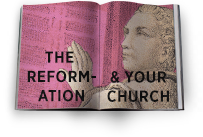Two Views on Church Authority: Protestant vs. Roman Catholic
Think of a three-legged stool.
Now imaginatively label one of those legs “Scripture,” label the second leg “Tradition,” and label the third leg “Magisterium” (I’ll explain these labels in a bit).
You now have a mental picture of the threefold authority structure of the Roman Catholic Church.
Now think of a marble column supporting, say, a statue. Imaginatively label that column “Scripture.”
You now have a mental picture of the authority structure of Protestant churches.
Two considerations should come immediately to mind. The authority structures of these two branches of Christendom are very different. One is like a three-legged stool; the other’s like a marble column. And there is one common element: Scripture.
THE ROMAN CATHOLIC STOOL
So let’s compare and contrast these two approaches to authority, imagining first the three-legged stool.
Scripture
Roman Catholic authority structure consists of three elements. The first, Scripture, is the written Word of God. The Catholic Church considers the Bible to be divinely inspired, authoritative (along with Tradition and the Magisterium), true (maybe even inerrant), and transformative for sinful people. Whereas the Roman Catholic New Testament is identical to the Protestant New Testament, their Old Testaments diverge. The Roman Catholic version contains the Apocrypha and its seven additional books: Tobit, Judith, Wisdom of Solomon, Ecclesiasticus, Baruch, and First and Second Maccabees. It also has additional sections in Esther and Daniel. Catholic beliefs such as purgatory (2 Maccabees 12:38–46) and meriting eternal life (Ecclesiasticus 16:14) are grounded in these extra writings. Importantly, though Roman Catholic and Protestant churches share Scripture, we must realize they don’t share the same Scripture.
Tradition
The second authoritative element is Tradition, which refers to the teachings of Jesus that he orally communicated to his apostles, who in turn orally communicated those teachings to their successors, the bishops of the church, who up until this day continue to nourish and protect them. At times, as head of the Catholic Church, the pope has proclaimed an aspect of this Tradition as official dogma that’s binding on the conscience of the Catholic faithful. For example, in 1854 Pope Pius IX announced the Immaculate Conception of Mary, and in 1950 Pope Pius XII proclaimed the Bodily Assumption of Mary.
Importantly, the Catholic Church “does not derive her certainty about all revealed truths from the holy Scriptures alone. Both Scripture and Tradition must be accepted and honored with equal sentiments of devotion and reverence.” Divine revelation consists of Scripture plus Tradition—not two sources, but two aspects of the authoritative revelation from God.
Magisterium
The Magisterium is the third authoritative element. This teaching office consists of the pope together with the bishops in unity with him. Among its responsibilities are the authoritative determination of the canon of Scripture, the authoritative interpretation of Scripture, and the authoritative pronouncement and interpretation of Tradition.
“Accordingly, the Catholic Church possesses a tripartite structure of authority: written Scripture, Tradition, and the Magisterium. Just as the three poles of a three-legged stool, provide support for whoever sits on it, these three elements provide divine revelation and its authoritative interpretation for the Church.”
THE PROTESTANT COLUMN
Now let’s switch from imagining a three-legged stool to imagining a marble column.
The Protestant authority structure consists of one element: Scripture as the written Word of God, divinely inspired, authoritative, true, sufficient, necessary, clear, and transformative for sinful people. In contrast to Roman Catholics, Protestants hold to sola Scriptura: Scripture is the church’s sole authority, ultimately determinative for doctrine, practice, faith, worship, and ministry. At the time of the Reformation, this principle was coupled with an explicit rejection of the Roman Catholic authority structure. Scripture alone, not Scripture plus Tradition plus the Magisterium, is the church’s authority.
Three qualifications are needed at this point: First, biblical authority must always be related to God himself, who as the sovereign Lord reveals himself and his ways through inspired, and thus authoritative, Scripture. God sustains the closest possible relationship to his Word. Accordingly, to obey God’s Word is to obey God himself. To disobey God’s Word is to disobey God himself. To trust God’s Word is to trust God himself. To mistrust God’s Word is to mistrust God himself. In the words of Timothy Ward: “God has so identified himself with his words that whatever someone does to God’s words . . . they do directly to God himself.” This affirmation does not equate God with his Word. But it does make clear that the God to whom all authority belongs to command what believers are to do and believe, and prohibit what they are not to do and believe, stands behind his authoritative Word.
Thus, the authority of the Word of God goes hand in hand with the authority of the Holy Spirit, who inspired that Word (2 Pet. 1:19–21; 2 Tim. 3:15–17) and enables the church to understand it (1 Cor. 2:10–16).
Second, sola Scriptura is the principle of ultimate authority and does not mean the church is without any other authority. Though Protestant churches rightly reject the Tradition (capital T) of the Catholic Church, they do not reject tradition (small t), or the accumulated wisdom of the historical church. Examples of tradition include the doctrines of the Trinity (one God, three persons) and of Christ (one person, two natures) that were forged in the early church.
Whereas Scripture possesses magisterial (leading) authority for Protestant churches, tradition possesses ministerial (serving) authority. Whereas Scripture enjoys ultimate authority, tradition enjoys presumptive authority: given the fact that it is grounded on Scripture, rightly summarizes Scripture, and has been cherished by the church from the beginning, tradition is to be regarded as a true secondary authority until proven wrong.
Third, Protestant churches are characterized by some type of authoritative governance. Within congregational churches, for example, pastors/elders exercise their office with the authority delegated to them by Jesus Christ, the head of the church. Thus, they are responsible to teach (1 Tim. 3:2; 5:17; Eph. 4:11), lead (1 Tim. 3:5; 5:17), pray (especially for the sick, James 5:13–16), and shepherd (1 Pet. 5:1–4). They possess the requisite authority to carry out these responsibilities. Church members also have responsibilities such as the acceptance and excommunication of members (Matt. 18:15–20) and affirming key decisions of their pastors (for example, the annual budget and changes to the church’s constitution). They also possess the requisite authority to carry out these responsibilities.
In other Protestant churches, bishops exercise an authoritative role (episcopalian governance) or local elders of a session exercise authority via presbyteries, synods, and general assemblies (presbyterian governance). None of these structures, however, comes close to approximating the authority of the Magisterium of the Roman Catholic Church.
On the eve of the 500th anniversary of the Protestant Reformation, our imagination should be fixed on a marble column rather than a three-legged stool. Sola Scriptura is more than just a Reformation motto. It’s the authoritative structure of Protestant churches.









